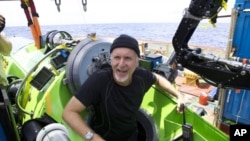A year after his historic solo dive to the bottom of the Challenger Deep in the Mariana Trench, movie director James Cameron has donated the vessel he used for the adventure to the Woods Hole Oceanographic Institution (WHOI) in Cape Cod, Massachusetts.
Scientists and engineers at Woods Hole will work with Cameron to incorporate the DEEPSEA CHALLENGER’s engineering innovations into future vessels to be used to explore the ocean’s depths.
Among the innovations incorporated into DEEPSEA CHALLENGER were new approaches to flotation, energy storage, camera and lighting systems that enabled Cameron to gather data, samples, and imagery during his descent to over 11,000 meters below the surface of the Western Pacific Ocean.
“The seven years we spent designing and building the DEEPSEA CHALLENGER were dedicated to expanding the options available to deep-ocean researchers. Our sub is a scientific proof-of-concept, and our partnership with the Woods Hole Oceanographic Institution is a way to provide the technology we developed to the oceanographic community,” said Cameron in a release. “I’ve been informally associated with WHOI for more than 20 years, and I welcome this opportunity to formalize the relationship. WHOI is a place where the DEEPSEA CHALLENGER system will be a living, breathing and dynamic program going forward.”
WHOI plans to use the cameras and lighting system from DEEPSEA CHALLENGER on the Hybrid Remotely Operated Vehicle Nereus, which dove to the Mariana Trench in 2009 and will return to trenches in the Atlantic and the Pacific during the next two years. Those systems enabled Cameron to capture 3D footage of geological processes and of underwater creatures.
“Jim’s record-breaking dive was inspirational and helped shine a spotlight on the importance of the deep ocean,” says Susan Avery, president and director of WHOI. “We face many challenges in our relationship with the ocean, so there is heightened urgency to implement innovative approaches. Partnerships such as this one represent a new paradigm and will accelerate the progress of ocean science and technology development.”
Cameron has logged more than 3,000 hours underwater and is a veteran of 85 submersible dives, and many of his movies reflect his interest in deep sea diving, including The Abyss, Titanic and a documentary on the German, World War II-era battleship, DKM Bismarck.
Scientists and engineers at Woods Hole will work with Cameron to incorporate the DEEPSEA CHALLENGER’s engineering innovations into future vessels to be used to explore the ocean’s depths.
Among the innovations incorporated into DEEPSEA CHALLENGER were new approaches to flotation, energy storage, camera and lighting systems that enabled Cameron to gather data, samples, and imagery during his descent to over 11,000 meters below the surface of the Western Pacific Ocean.
“The seven years we spent designing and building the DEEPSEA CHALLENGER were dedicated to expanding the options available to deep-ocean researchers. Our sub is a scientific proof-of-concept, and our partnership with the Woods Hole Oceanographic Institution is a way to provide the technology we developed to the oceanographic community,” said Cameron in a release. “I’ve been informally associated with WHOI for more than 20 years, and I welcome this opportunity to formalize the relationship. WHOI is a place where the DEEPSEA CHALLENGER system will be a living, breathing and dynamic program going forward.”
WHOI plans to use the cameras and lighting system from DEEPSEA CHALLENGER on the Hybrid Remotely Operated Vehicle Nereus, which dove to the Mariana Trench in 2009 and will return to trenches in the Atlantic and the Pacific during the next two years. Those systems enabled Cameron to capture 3D footage of geological processes and of underwater creatures.
“Jim’s record-breaking dive was inspirational and helped shine a spotlight on the importance of the deep ocean,” says Susan Avery, president and director of WHOI. “We face many challenges in our relationship with the ocean, so there is heightened urgency to implement innovative approaches. Partnerships such as this one represent a new paradigm and will accelerate the progress of ocean science and technology development.”
Cameron has logged more than 3,000 hours underwater and is a veteran of 85 submersible dives, and many of his movies reflect his interest in deep sea diving, including The Abyss, Titanic and a documentary on the German, World War II-era battleship, DKM Bismarck.









